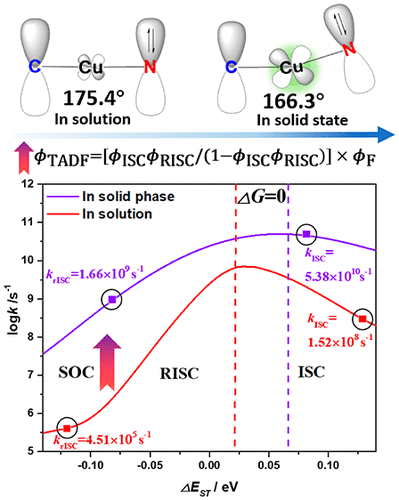当前位置:
X-MOL 学术
›
J. Phys. Chem. Lett.
›
论文详情
Our official English website, www.x-mol.net, welcomes your
feedback! (Note: you will need to create a separate account there.)
Aggregation-Enhanced Thermally Activated Delayed Fluorescence Efficiency for Two-Coordinate Carbene–Metal–Amide Complexes: A QM/MM Study
The Journal of Physical Chemistry Letters ( IF 4.8 ) Pub Date : 2021-03-16 , DOI: 10.1021/acs.jpclett.1c00020
Shiyun Lin 1 , Qi Ou 1 , Yu Wang 1 , Qian Peng 2 , Zhigang Shuai 1
The Journal of Physical Chemistry Letters ( IF 4.8 ) Pub Date : 2021-03-16 , DOI: 10.1021/acs.jpclett.1c00020
Shiyun Lin 1 , Qi Ou 1 , Yu Wang 1 , Qian Peng 2 , Zhigang Shuai 1
Affiliation

|
The two-coordinate carbene–metal–amide complexes have attracted a great deal of attention due to their remarkable thermally activated delayed fluorescence (TADF) properties, giving them promise in organic light-emitting diode application. To reveal the inherent mechanism, we take CAAC–Cu(I)–Cz and CAAC–Au(I)–Cz as examples to investigate the photophysical properties in solution and solid phases by combining quantum mechanics/molecular mechanics approaches for the electronic structure and the thermal vibration correlation function formalism for the excited-state decay rates. We found that both intersystem crossing (ISC) and its reverse (rISC) are enhanced by 2–4 orders of magnitude upon aggregation, leading to highly efficient TADF, because (i) the metal proportion in the frontier molecular orbitals increases, leading to an enhanced spin–orbit coupling strength between S1 and T1, and (ii) the reaction barriers for ISC and rISC are much lower in solution than in aggregate phases through a decrease in energy gap ΔEST and an increase in the relative reorganization energy through bending the angle ∠C2–Cu–N1 for T1. We propose a pump–probe time-resolved infrared spectroscopy study to verify the mechanism. These findings can clarify the ongoing dispute over the understanding of the high TADF quantum efficiency for two-coordinate metal complexes.
中文翻译:

两坐标碳-金属-酰胺配合物的聚集增强的热活化延迟荧光效率:QM / MM研究
卡宾-金属-酰胺二配位化合物由于具有出色的热活化延迟荧光(TADF)特性而备受关注,这使其在有机发光二极管应用中具有广阔的前景。为了揭示其内在机理,我们以CAAC–Cu(I)–Cz和CAAC–Au(I)–Cz为例,通过结合量子力学/分子力学方法对电子结构和固相进行光物理性质研究。激发态衰减率的热振动相关函数形式主义。我们发现,聚集后,系统间交叉(ISC)及其反向(rISC)都提高了2–4个数量级,从而导致了高效的TADF,这是因为(i)前沿分子轨道中的金属比例增加了,1和T 1;以及(ii)通过减小能隙ΔE ST和通过弯曲角度∠C2-Cu来增加相对重组能,ISC和rISC的反应势垒在溶液中比在聚集相中要低得多。– N1表示T 1。我们提出了一种泵-探针时间分辨红外光谱研究,以验证其机理。这些发现可以澄清关于二配位金属络合物对高TADF量子效率理解的争论。
更新日期:2021-03-25
中文翻译:

两坐标碳-金属-酰胺配合物的聚集增强的热活化延迟荧光效率:QM / MM研究
卡宾-金属-酰胺二配位化合物由于具有出色的热活化延迟荧光(TADF)特性而备受关注,这使其在有机发光二极管应用中具有广阔的前景。为了揭示其内在机理,我们以CAAC–Cu(I)–Cz和CAAC–Au(I)–Cz为例,通过结合量子力学/分子力学方法对电子结构和固相进行光物理性质研究。激发态衰减率的热振动相关函数形式主义。我们发现,聚集后,系统间交叉(ISC)及其反向(rISC)都提高了2–4个数量级,从而导致了高效的TADF,这是因为(i)前沿分子轨道中的金属比例增加了,1和T 1;以及(ii)通过减小能隙ΔE ST和通过弯曲角度∠C2-Cu来增加相对重组能,ISC和rISC的反应势垒在溶液中比在聚集相中要低得多。– N1表示T 1。我们提出了一种泵-探针时间分辨红外光谱研究,以验证其机理。这些发现可以澄清关于二配位金属络合物对高TADF量子效率理解的争论。































 京公网安备 11010802027423号
京公网安备 11010802027423号